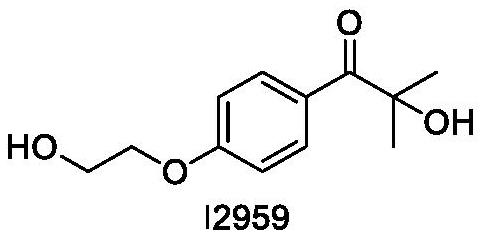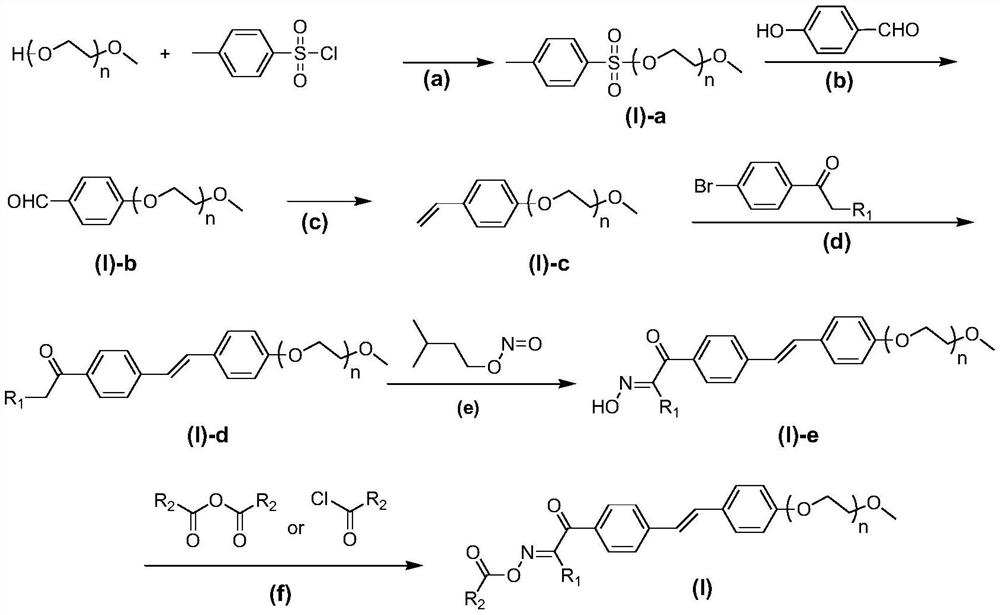A kind of LED-sensitive distyryl oxime ester type photoinitiator and its preparation and application
A distyryl-based, photoinitiator technology, applied in oxime preparation, organic chemistry, etc., can solve the problems of poor water solubility and low absorption
- Summary
- Abstract
- Description
- Claims
- Application Information
AI Technical Summary
Problems solved by technology
Method used
Image
Examples
Embodiment 1
[0039] Example 1: Preparation of Exemplary Compound (I)-1
[0040]
[0041] (a) in a single-necked flask, add ethylene glycol monomethyl ether (50mmol) and triethylamine (55mmol) in 100 ml of dichloromethane, place at room temperature and stir, dropwise add p-toluenesulfonyl chloride ( 55 mmol) in dichloromethane. After 5 hours, TCL monitored the disappearance of the raw materials, 100 ml of deionized water was added to the system, extracted with dichloromethane, the organic layer was evaporated to dryness under reduced pressure, and the product was an orange liquid with a yield of 95.64%.
[0042] (b) Add 2-(2-(2-methoxyethoxy)ethoxy)ethyl 4-methylbenzenesulfonate (48mmol), p-hydroxybenzaldehyde (48mmol) and carbonic acid to a single-necked flask Potassium (58 mmol) in 80 mL of N,N-dimethylformamide (DMF) was placed in a 110°C oil bath to stir the reaction. After 3 hours, TCL monitored the disappearance of raw materials, concentrated DMF under reduced pressure, added 50 ml...
Embodiment 2
[0047] Example 2: Preparation of Initiators 2-16
[0048] The preparation methods of these initiators are similar to the initiator (I)-1 prepared in Example 1, except that 4-bromobenzophenone with different substituents is used in step d and different acid chlorides or acid anhydrides are used in step f. As in step d, (I)-11 and (I)-12 use the same 4-bromopropiophenone as (I)-1, and (I)-2, (I)-13, (I)-14 Use 4-bromobutanone, (I)-3 use 1-(4-bromophenyl)-2-phenylethan-1-one, (I)-4 use 1-(4-bromophenyl) -2-(p-Tolyl)ethane-1-one, (I)-5 used 1-(4-bromophenyl)-2-(4-(trifluoromethyl)phenyl)ethane-1- ketone, (I)-6 used 4-bromovalerophenone. In step f, (I)-2, (I)-3, (I)-4 and (I)-5 use the same acetic anhydride or acetyl chloride as (I)-1, while (I)-6 and (I)-5 use the same acetic anhydride or acetyl chloride as (I)-1. (I)-13 uses propionic anhydride or propionyl chloride, (I)-7 uses butyric anhydride or butyryl chloride, (I)-8 uses valeric anhydride or valeryl chloride, (I)-9 and (...
Embodiment 3
[0062] Example 3: Preparation of Initiators 15-20
[0063] The preparation methods of these initiators are similar to those of Initiator 1, except that oxime ester-type photoinitiators with different degrees of water solubility are prepared by using ethylene acetal monomethyl ethers of different lengths. For example, (I)-15 uses tetraethylene glycol monomethyl ether, (I)-16 uses pentaethylene glycol monomethyl ether, (I)-17 uses hexaethylene glycol monomethyl ether, (I)- 18, (I)-19 and (I)-20 used octaethylene glycol monomethyl ether.
[0064] (I)-15, 56% yield, yellow solid. HR-MS(C 28 H 35 NO 8 ): m / e: 513.2363; experimental result: 514.2345 (M+H + ).
[0065] (I)-16, 55% yield, yellow solid. HR-MS(C 30 H 39 NO 9 ): m / e: 557.2625; experimental result: 558.2635 (M+H + ).
[0066] (I)-17, 57% yield, yellow solid. HR-MS(C 32 H 43 NO 10 ): m / e: 601.2887; experimental result: 602.2875 (M+H + ).
[0067](I)-18, 60% yield, yellow solid. HR-MS(C 36 H 51 NO 12 )...
PUM
 Login to View More
Login to View More Abstract
Description
Claims
Application Information
 Login to View More
Login to View More - R&D
- Intellectual Property
- Life Sciences
- Materials
- Tech Scout
- Unparalleled Data Quality
- Higher Quality Content
- 60% Fewer Hallucinations
Browse by: Latest US Patents, China's latest patents, Technical Efficacy Thesaurus, Application Domain, Technology Topic, Popular Technical Reports.
© 2025 PatSnap. All rights reserved.Legal|Privacy policy|Modern Slavery Act Transparency Statement|Sitemap|About US| Contact US: help@patsnap.com



